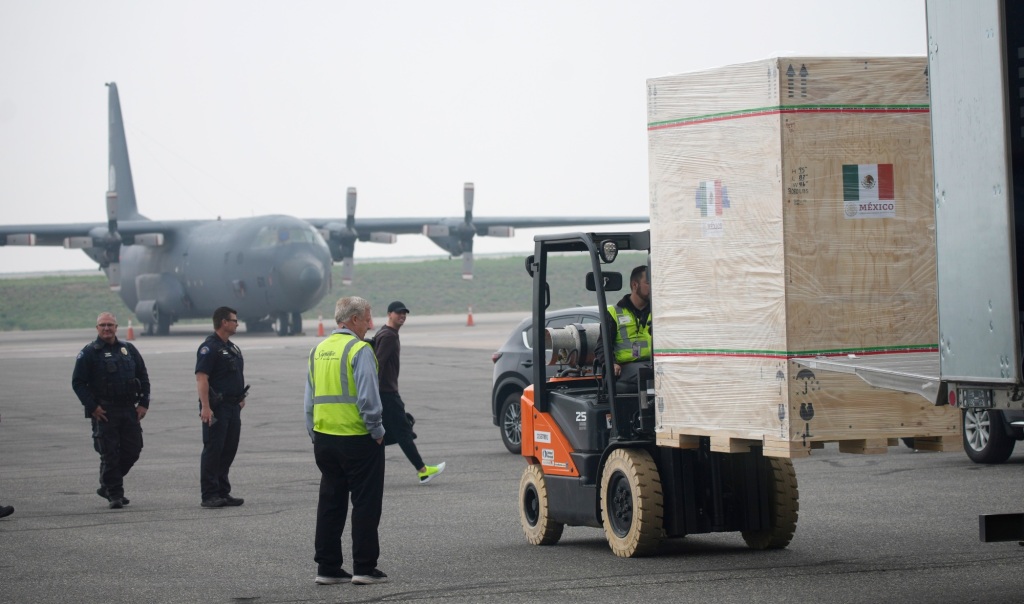The Mexican delegation stood on the tarmac Friday afternoon near Denver International Airport, waiting under hazy skies for a forklift to deliver a wooden box, the contents of which archaeologists have been searching for nearly two decades.
Inside that box — 95 inches tall, 46 inches wide, emblazoned with the Mexican flag — sat a 2,000-pound, elaborately carved stone from the ancient Olmec civilization, a precursor to the Mayans who thrived more than 2,500 years ago near the Gulf of Mexico.
The prized relic, known as Monument 9 or the Earth Monster, was carefully crafted between 800 and 400 B.C. out of volcanic rock, archaeologists believe. Its wide mouth represents the door to the underworld.
“This is one of the pieces we have been looking for for the longest time,” said Jorge Islas, Mexico’s consul general in New York.
Authorities believe the stone artifact was stolen in the late 1950s or early 1960s from the central Mexican state of Morelos. It was exhibited in New York’s famed Metropolitan Museum of Art in the 1970s, and sometime after made its way into the hands of an unnamed private collector or collectors in Colorado.
Now the stone artifact — with an estimated $12 million value — is headed back to its ancestral homeland after authorities seized it Friday, part of a long-term investigation by the Manhattan District Attorney’s Office into stolen Olmec antiquities.
“This is testimony our nation is recovering our great patrimony,” Marcelo Ebrard Casaubon, Mexico’s foreign secretary, said during a news conference.
“A decisive civilization”
Monument 9 isn’t just any old Mexican antiquity.
The Olmecs were the earliest known major Mesoamerican civilization, dominating the tropical lowland of the modern-day Mexican states of Veracruz and Tabasco south of Mexico City.
Architecture from the Olmecs is quite advanced, said Mario Córdova, an archaeologist who accompanied the Mexican delegation to Denver. That’s why it’s so valued and desired.
“It was a decisive civilization,” Casaubon said.
The Earth Monster sports iconography of jaguars, revered as the most dangerous animal in Central and South America, as well as sacred mountains and indigenous plants.
Archaeologists don’t know how much was taken from the Chalcatzingo Archaeological Zone, but the looting was significant, Córdova said. Mexican authorities believe sometime in the late 1950s or early 1960s, looters broke Monument 9 into pieces and smuggled it into the United States.
The statue first appeared in a 1968 issue of American Antiquity, an archaeology journal, Mexican authorities said.

The Met exhibited the work from July 1970 through February 1971 as part of its Before Cortes exhibition, a museum spokesperson said. The relic was on loan to the museum from the Munson-Williams-Proctor Arts Institute in Utica, NY.
Córdova and other archaeologists spent the past 18 years looking for this significant piece of Mexican history. It’s not clear when, or how, the multimillion-dollar antiquity made its way into the hands of the Colorado collectors.
Authorities didn’t divulge these individuals’ identities on Friday.
“They got a settlement,” Islas told The Denver Post. “They’re super famous, super wealthy people.”
The Mexican government approached the Manhattan District Attorney’s Office with evidence that the artifact had been stolen and authorities located it this year, said Alejandro Celorio, principal legal advisor for Mexico’s foreign ministry.
Douglas Cohen, a spokesperson for the Manhattan DA’s office, said Friday’s seizure came as part of a long-term investigation into stolen Olmec antiquities. The office sports an antiquities trafficking unit that spearheads some of the country’s largest art-crime investigations. In recent months, the team returned stolen artifacts to Iraq, China and Yemen, among other countries.
Recovering lost heritage
The Mexican government in recent years has prioritized cultural property repatriation efforts, scouring the globe for artifacts it believes to have been looted.
President Andrés Manuel López Obrador even launched a campaign under the hashtag #MiPatrimonioNoSeVende (“My heritage is not for sale”).
In March, authorities in France, Italy and Germany returned 86 cultural objects to Mexico. The Netherlands in December, meanwhile, returned 223 objects to the Latin American nation.
The country’s efforts come as the global south has increasingly pressed for the return of its heritage after decades of plundering and colonial rule. Museums and private collectors have faced increasing pressure — and attention from law enforcement — over the provenance of antiquities.
Córdova could hardly contain his glee as he stood on the tarmac at the private aviation terminal next to Denver’s airport.
In minutes, the archeologist would accompany the enormous wooden box on a military plane, headed for Mexico. Monument 9 by next week will be displayed at the Palace of Cortés, the famous conquistador’s former residence in Cuernavaca.
“I didn’t believe this was possible,” Córdova said in Spanish through an interpreter. “I’m just so happy.”
𝗖𝗿𝗲𝗱𝗶𝘁𝘀, 𝗖𝗼𝗽𝘆𝗿𝗶𝗴𝗵𝘁 & 𝗖𝗼𝘂𝗿𝘁𝗲𝘀𝘆: www.mercurynews.com
𝗙𝗼𝗿 𝗮𝗻𝘆 𝗰𝗼𝗺𝗽𝗹𝗮𝗶𝗻𝘁𝘀 𝗿𝗲𝗴𝗮𝗿𝗱𝗶𝗻𝗴 𝗗𝗠𝗖𝗔,
𝗣𝗹𝗲𝗮𝘀𝗲 𝘀𝗲𝗻𝗱 𝘂𝘀 𝗮𝗻 𝗲𝗺𝗮𝗶𝗹 𝗮𝘁 dmca@enspirers.com


